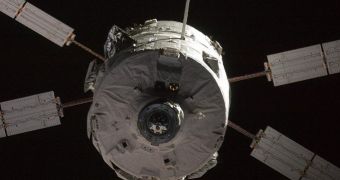Following the successful mission of the ATV Jules Verne last year, the European Space Agency (ESA) is currently working on its second Automated Transfer Vehicle, called Johannes Kepler. This class of spacecraft is designed specifically for rendezvous with the International Space Station (ISS), and is able to carry vital provisions, supplies and scientific equipment to the orbital facility. Its mission will become all the more important come 2011, as the Americans plan to retire their aging shuttle fleet this September. NASA has only five flights planned for this year, Space Fellowship reports.
Kepler is currently undergoing its first flightworthiness and functionality tests. The work is being conducted at the EADS Astrium facility in Bremen, as the company is in charge of the ATV's building and initial preparation stages. According to officials at the corporation, the new space capsule will be delivered to its rightful owner, ESA, this November. The European Aeronautic Defense and Space Company (EADS) employs more than 15,000 people, in countries such as France, Germany, the United Kingdom, Spain and the Netherlands.
“After successfully integrating the propulsion module and avionics unit into the spacecraft over the last month, we can now start testing 'Johannes Kepler' as a complete unit for the first time. To do that, the spacecraft and logistics modules will be connected to each other in a soft configuration, i.e. using electrical connecting cables,” the EADS Astrium Senior Vice-President and head of Orbital Systems and Exploration, Dr. Michael Menking, explains. In addition to the hardware that goes on the new ATV, the tests are also meant to assess the durability and performances of the software components, such as the flight programs, which deal with the fully automated process of guiding ATVs to their appropriate docking ports on the ISS.
ESA will take control of the finished Johannes Kepler ATV directly at its spaceport. The facility is located in Kourou, French Guyana, as the southern hemisphere launch pads benefit from better conditions than their northern hemisphere-based counterparts. After the spacecraft is delivered, engineers will conduct the final assembly stage of the mission. This means that the module itself, its solar panels, the Integrated Cargo Carrier (ICC), and the Separation and Distancing Module (SDM) will be mated together. These instruments form what is collectively known as the Interface, connecting the second-ever ATV with its Ariane V heavy-lift delivery system.
Engineers at EADS Astrium reveal that a large number of tests and assessments will then be conducted on the completed launch setup, so as to determine any possible factors that may hinder the launch attempt, or Kepler's safety. “If everything runs to plan, we will be able to launch our second mission to the ISS in November 2010,” Menking says. The contract between EADS and ESA lasts until 2015, with an additional three ATVs scheduled for construction. After that time, the faith of the ISS itself is uncertain. However, if the countries involved in the international platform decide to continue with the project beyond 2015, there is a distinct possibility that the ESA-EADS contract will be prolonged.

 14 DAY TRIAL //
14 DAY TRIAL //